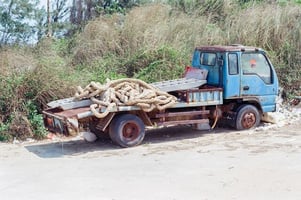If you’ve ever struggled with hitching your trailer or dreaded the moment you have to unhitch after a long haul, you’re not alone. Even seasoned towers can feel a little anxious when it comes to lining things up, setting weight distribution, and getting all the components just right.
That’s why the ProPride 3P Hitch isn’t just about eliminating sway—it’s about empowering you to tow with total confidence. But to unlock its full potential, you need to master the art of proper hitching and unhitching.
In this blog, you’ll learn:
- The complete step-by-step process for safe hitching and unhitching
- Expert tips to avoid common mistakes and speed up setup
- How to get the most out of your ProPride 3P every time you tow
Let’s walk through the process together and make smooth, secure towing your new standard.
Step-by-Step Guide to Hitching Your ProPride 3P Trailer Hitch
Getting hitched might sound romantic—but in the towing world, it’s all about safety, precision, and peace of mind. Hitching your ProPride 3P isn’t difficult, but it does require the right technique. Let’s break it down.
Step 1: Position and Align Your Vehicle
Before anything else, position your towing vehicle and trailer on a flat, level surface. This ensures a safe setup and prevents rolling or misalignment.
- Use your mirrors or backup camera to slowly reverse toward the trailer.
- Line up the vehicle hitch ball directly under the trailer coupler.
- Don’t rush—small, deliberate adjustments work best.
Pro Tip: If you’re hitching solo, consider using a hitch alignment system or magnetic guide poles.
Step 2: Lower the Coupler onto the Hitch Ball
Once your alignment looks good:
- Ensure the coupler latch is open.
- Use the trailer jack to lower the coupler onto the ball until it’s fully seated.
- Close the latch and secure it with a pin or lock.
You should feel the trailer settle snugly onto the hitch—if not, realign slightly and try again.
Step 3: Lock In Your Weight Distribution System
The hitch uses weight distribution jacks and bars to stabilize your tow and reduce sag.
Here’s how to engage it:
- Adjust the weight distribution jacks to match your tongue weight.
- Attach the sway control yoke to the tow vehicle and tighten bolts to the manufacturer's specs.
- Secure the pivot hardware to allow for proper articulation.
This setup redistributes weight between your trailer and tow vehicle axles, reducing sway and improving steering control.
Step 4: Attach the Sway Control Bars
Your anti-sway system is what sets ProPride apart. Follow these key steps:
- Slide the trunnion bars into the hitch head and frame brackets.
- Ensure they’re locked securely and evenly on both sides.
- Double-check the angle and tension—these affect how well sway is eliminated on the road.
Safety Note: Never tow without both sway bars connected. They’re essential for full 3P functionality.
Step 5: Connect Safety Chains the Right Way
It’s tempting to slap on your chains and move on—but there’s a method that matters.
- Cross the safety chains under the coupler in an “X” pattern.
- Attach to the tow vehicle frame using rated hooks or loops.
- Ensure they’re not dragging but still have enough slack for turns.
This creates a cradle that will catch the trailer tongue if it ever becomes unhitched.
Step 6: Plug in the Trailer’s Electrical System
Your lights and brakes are just as important as your hitch.
- Plug the trailer wiring harness into the tow vehicle.
- Test brake lights, turn signals, and running lights.
- Verify the electric brake controller function if your trailer uses it.
Never skip this test—visibility and braking are non-negotiables for road safety.
Troubleshooting Tips While Hitching
Even with experience, little hiccups can happen. Here’s a quick reference table to help you identify and solve common issues.
|
Problem |
Possible Cause |
Quick Fix |
|
Coupler won’t lower onto ball |
Misalignment or uneven ground |
Re-align vehicle or reposition trailer |
|
Bars too tight or too loose |
Incorrect angle or bar placement |
Adjust bar tension per manual |
|
Trailer feels nose-high or low |
Improper hitch head height |
Raise or lower hitch ball assembly |
|
Chains are dragging |
Too much slack or wrong hooks |
Shorten chain or switch hook point |
|
Lights not working |
Loose harness connection or blown fuse |
Reconnect securely and check tow vehicle |
How to Unhitch Your ProPride 3P Trailer Hitch
Unhitching your trailer might seem like a simple reversal of the hitching process—but there are specific steps that ensure safety, prevent equipment strain, and make your post-trip experience smooth.
Let’s walk through it.
Step 1: Park, Secure, and Chock the Wheels
Start by finding a level parking spot. Engage your tow vehicle’s parking brake, and use wheel chocks on both sides of the trailer tires to prevent rolling.
Pro Tip: Never skip chocking—even on level ground. Safety starts here.
Step 2: Disconnect the Electrical System
Unplug the trailer’s wiring harness from the tow vehicle’s connector. Be gentle—pulling forcefully can damage the plug pins or wiring insulation.
- Store the plug in a dry, protected spot.
- Check the harness for dirt, wear, or fraying.
Step 3: Unhook the Safety Chains and Sway Bars
Follow this order:
- Unclip and remove the safety chain hooks from the tow vehicle.
- Uncross the chains and set them aside.
- Detach the trunnion sway bars from both the hitch head and frame brackets.
Safety Reminder: Always relieve any tension in the sway bars before removing them.
Step 4: Lift the Trailer Coupler Off the Hitch Ball
Using your trailer jack:
- Raise the trailer tongue until the coupler clears the hitch ball.
- Ensure the coupler latch is open.
- Once it’s clear, slowly pull your vehicle forward to separate.
Avoid jerky movements, especially if you're on uneven terrain or loose gravel.
Bonus Tips for Effortless Unhitching
Want to make unhitching smoother every time? Keep these tips in mind:
- Keep leveling blocks handy to stabilize uneven ground.
- Spray coupler components with lubricant every few trips.
- Keep gloves in your tool kit to stay clean and improve grip.
Make Every Tow Smooth, Start to Finish
Learning how to properly hitch and unhitch your ProPride 3P Hitch is one of the smartest things you can do as a trailer owner. It’s not just about mechanics—it’s about building a routine you can rely on, trip after trip.
By mastering each step, you’re ensuring maximum sway control, safer hauls, and fewer surprises along the way. Whether you’re loading up for a weekend getaway or wrapping up a long haul, the right technique makes every mile more enjoyable.
Practice leads to confidence. And with ProPride, you’ve already got the right equipment—now you’ve got the know-how, too.
Frequently Asked Questions
Hitching and unhitching might seem straightforward, but the finer details can make or break your experience. Here are some important questions trailer owners often ask once they’ve started using the ProPride 3P.
Can I hitch or unhitch on uneven ground?
Yes, but it’s not ideal. Always aim for level ground to ensure your hitch components align properly. If unavoidable, use leveling blocks under tires or jack stands to create a stable base before proceeding.
What should I do if the sway bars are stuck during unhitching?
If the sway bars feel jammed, your trailer might be on an angle or under tension. Try raising the tongue slightly to release pressure, then gently wiggle the bars free. Never force them—they should slide out smoothly.
Do I need tools for hitching and unhitching the ProPride 3P?
Only basic tools are needed—typically, a wrench for initial setup adjustments. Day-to-day hitching and unhitching require no tools unless you’re reconfiguring your setup or adjusting bar tension for a different trailer load.
Can I leave the sway bars attached when parked overnight?
It’s recommended to remove them. Leaving sway bars under tension while parked can strain the brackets and increase wear. For overnight stops or uneven parking, always remove the bars and secure them safely.
How often should I inspect my hitch setup?
Give it a visual check every time you tow. Look for signs of rust, pin wear, loose bolts, or frayed chains. A more thorough inspection—lubrication and bolt torquing—should be done monthly or before long-distance trips.


